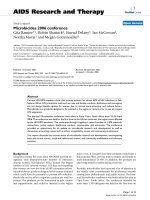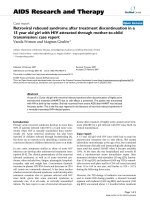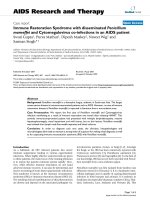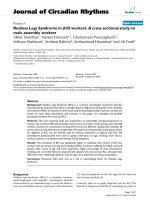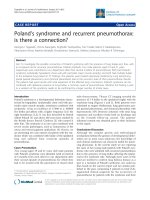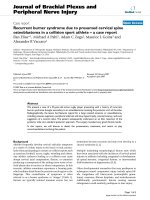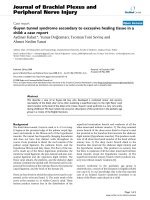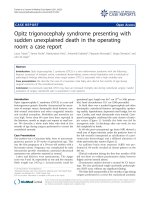Báo cáo y học: "Red man syndrome" docx
Bạn đang xem bản rút gọn của tài liệu. Xem và tải ngay bản đầy đủ của tài liệu tại đây (36.91 KB, 3 trang )
119
Available online />The incidence of nosocomial infections in hospitalized
patients varies between 5 and 15% [1]. Nosocomial infection
can lead to complications in 25–33% of those patients
admitted to intensive care units. Vancomycin is often used in
intensive care units. It is the drug of choice for the treatment
of infections due to methicillin-resistant staphylococci,
Corynebacterium jeikeium, and resistant strains of
Streptococcus pneumoniae. Vancomycin is an alternative
drug for serious staphylococcal and streptococcal infections,
including endocarditis, when allergy precludes the use of
penicillins and cephalosporins.
Vancomycin can cause two types of hypersensitivity
reactions, the red man syndrome and anaphylaxis [2]. Red
man syndrome is an infusion-related reaction peculiar to
vancomycin [3]. It typically consists of pruritus, an
erythematous rash that involves the face, neck, and upper
torso. Less frequently, hypotension and angioedema can
occur. Patients commonly complain of diffuse burning and
itching and of generalized discomfort. They can rapidly
become dizzy and agitated, and can develop headache,
chills, fever, and paresthesia around the mouth. In severe
cases, patients complain of chest pain and dyspnea. In many
patients, the syndrome is a mild, evanescent pruritus at the
end of the infusion that goes unreported.
Signs of red man syndrome would appear about 4–10 min
after an infusion started or may begin soon after its
completion. It is often associated with rapid (< 1 hour)
infusion of the first dose of vancomycin. The reaction may not
be of the same severity with successive exposures, but it can
occur for the first time after several doses or with a slow
infusion [4]. Delayed reactions at or near the end of a 90 or
120 min infusion have been seen in patients who had been
on vancomycin therapy for longer than 7 days without prior
incident [5]. Most of the hospital protocols require
vancomycin to be infused over 60 min, as a minimum [5,6].
Sporadic reports of red man syndrome following the
administration of vancomycin via routes other than
intravenously are also on the increase. Red man syndrome
has been linked to intraperitoneal and oral administration of
vancomycin [7].
Red man syndrome was in the past attributed to impurities
found in vancomycin preparations, earning the drug the
nickname ‘Mississippi mud’. But reports of the syndrome
persisted even after improvements in the compound’s purity
[5]. Studies have shown that an unknown percentage of the
population may be prone to releasing a large amount of
histamine in response to vancomycin [6]. The hypersensitivity
reactions that can arise due to vancomycin are due to its
Commentary
Red man syndrome
Soupramanien Sivagnanam
1
and Dirk Deleu
2
1
Senior Registrar, Department of Anaesthesia & Intensive Care, Sultan Qaboos University Hospital, Al Khod, Muscat, Oman
2
Associate Professor, Department of Clinical Pharmacology, College of Medicine, Sultan Qaboos University, Al Khod, Muscat, Oman
Correspondence: Soupramanien Sivagnanam,
Published online: 23 December 2002 Critical Care 2003, 7:119-120 (DOI 10.1186/cc1871)
This article is online at />© 2003 BioMed Central Ltd (Print ISSN 1364-8535; Online ISSN 1466-609X)
Abstract
Vancomycin can cause two types of hypersensitivity reactions, the red man syndrome and anaphylaxis.
Red man syndrome has often been associated with rapid infusion of the first dose of the drug and was
initially attributed to impurities found in vancomycin preparations. Even after improvement in
vancomycin’s purity, however, reports of the syndrome persist. Other antibiotics (e.g. ciprofloxacin,
amphotericin B, rifampicin and teicoplanin) or other drugs that stimulate histamine release can result in
red man syndrome. Discontinuation of the vancomycin infusion and administration of diphenhydramine
can abort most of the reactions. Slow intravenous administration of vancomycin should minimize the
risk of infusion-related adverse effects.
Keywords antibiotics, antihistamines, red man syndrome, vancomycin
120
Critical Care 2003 Vol 7 Sivagnanam and Deleu
effect on the mast cells. In tissue culture, vancomycin causes
degranulation of peritoneal mast cells in rats [8]. The
anaphylactic reaction is mediated by IgE. Red man syndrome,
an anaphylactoid reaction, is caused by the degranulation of
mast cells and basophils, resulting in the release of histamine
independent of preformed IgE or complement. The extent
of histamine release is related partly to the amount and
rate of the vancomycin infusion. Clinical studies have
shown that the plasma tryptase levels were not
significantly elevated in confirmed anaphylactoid reactions,
so they can be used to distinguish chemical reactions from
immunologic reactions [9].
The most common hypersensitivity reaction associated with
vancomycin is red man syndrome. The incidence varies
between 3.7 and 47% in infected patients [2]. Studies of
vancomycin also show that the most severe reactions occur
in patients younger than the age of 40, particularly in children
[6]. Other research has found that between 30 and 90% of
healthy volunteers receiving vancomycin developed red man
syndrome, while only about 47% of those with infections had
the reaction [10]. One explanation for these results is that an
infection induces some histamine release as part of the
natural immune response. Having a higher histamine level to
begin with is thought to downregulate vancomycin’s effect on
mast cells and basophils. It occurs in 5–13% of patients,
especially when the infusion is given over less than 1 hour
[11]. Polk and colleagues [12] observed the reaction during
a 1 hour infusion of 1 g vancomycin in nine of 11 volunteers
(82%), which was associated with a rise in plasma histamine
levels. No reaction occurred with a 500 mg dose. Healy and
colleagues [13] noted symptoms in eight of 10 volunteers
(80%) given 1 g vancomycin over 1 hour, but in only three of
10 volunteers (30%) given the same dose over 2 hours. Total
histamine release was greater with the faster infusion.
Antibiotics such as ciprofloxacin, amphotericin B, rifampcin
and teicoplanin [14] can potentially cause red man
syndrome. Like vancomycin, they are capable of causing
direct degranulation of mast cells and basophils. Red man
syndrome is amplified if these antibiotics are combined with
vancomycin or with each other [10]. Red man syndrome is
also magnified in patients receiving vancomycin and opioid
analgesics, muscle relaxants, or contrast dye because these
drugs can also stimulate histamine release.
The effects of red man syndrome can be relieved by
antihistamines. Pretreatment with hydroxyzine can
significantly reduce erythema and pruritus [15].
Administration of diphenhydramine to patients before starting
vancomycin infusion (1 g over 1 hour) can prevent the
occurrence of red man syndrome with the first dose of
vancomycin [16]. Other studies have shown that combining
an H
1
receptor blocker with an H
2
receptor blocker such as
cimetidine may help to prevent or reduce the risk of red man
syndrome [5].
If red man syndrome appears then the vancomycin infusion
should be discontinued immediately. A dose of 50 mg
diphenhydramine hydrochloride intravenously or orally can
abort most of the reactions. Once the rash and itching
dissipate, the infusion can be resumed at a slower rate
and/or at a lesser dosage. Hypotension will require
intravenous fluids and, if severe, vasopressors may be
needed. Hypotension can be troublesome if it occurs during
anesthesia following the use of vancomycin for surgical
prophylaxis [17,18]. Therapy with a β-blocker before surgery
has been found to be protective against hypotension caused
by vancomycin infusion [19].
In summary, each intravenous dose of vancomycin should be
administered over at least a 60 min interval to minimize the
infusion-related adverse effects [20]. Longer infusion times
should be used in patients receiving doses considerably
larger than 1 g vancomycin. Studies have shown that
vancomycin is much better tolerated when it is given in
smaller and more frequent doses [20]. In clinical situations
where prolonged infusion times are often impractical, as in
the intensive care unit or an operative setting, especially
ambulatory orthopedic or emergency procedures,
pretreatment with antihistamines combined with an H
2
receptor blocker can offer protection against this infusion-
related reaction with vancomycin [5].
Competing interests
None declared.
References
1. Eggimann P, Pittet D: Infection control in the ICU. Chest 2001,
120:2059-2093.
2. Lori D Wazny, Behnam D: Desensitization protocols for van-
comycin hypersensitivity. Ann Pharmacother 2001, 35:1458-
1464.
3. Davis RL, Smith AL, Koup JR: The ‘red man’s syndrome’ and
slow infusion of vancomycin [letter]. Ann Intern Med 1986,
104:285-286.
4. Wilson APR: Comparative safety of teicoplanin and van-
comycin. Int J Antimicrobial Agents 1998, 10:143-152.
5. Renz CL, Thurn JD, Finn HA, Lynch JP, Moss J: Clinical investi-
gations: antihistamine prophylaxis permits rapid vancomycin
infusion. Crit Care Med 1999, 27:1732-1737.
6. Korman T, Turnidge J, Grayson M: Risk factors for cutaneous
reactions associated with intravenous vancomycin. J Antimi-
crob Chemother 1997, 39:371-381.
7. Bergeron L, Boucher F: Possible red-man syndrome associ-
ated with systemic absorption of oral vancomycin in a child
with normal renal function. Ann Pharmacother 1994, 28:581-
584.
8. Williams PD, Laska DA, Shetler TJ, McGrath JP, White SL,
Hoover DM: Vancomycin-induced release of histamine from
rat peritoneal mast cells and a rat basophil cell line (RBL-1).
Agents Actions 1991, 32:217-223.
9. Renz CL, Laroche D, Thurn JD, Finn HA, Lynch JP, Thisted R,
Moss J: Tryptase levels are not increased during vancomycin-
induced anaphylactoid reactions. Anesthesiology 1998,
89:620-625.
10. Ross M: Red-man syndrome: a preventable adverse drug reac-
tion [www.vh.org/Providers/Publications/PTNews/993/12.93.html],
15 August 2001.
11. Wallace M, Mascola J, Oldfiels Ill E: Red-man syndrome: Inci-
dence, etiology, and prophylaxis. J Infect Dis 1991, 164:1180-
1185.
121
12. Polk RE, Healy DP, Schwartz LB, Rock DT, Garson ML, Roller K:
Vancomycin and the red-man syndrome: pharmacodynamics
of histamine release. J Infect Dis 1988, 157:502-507.
13. Healy DP, Sahai JV, Fuller SH, Polk RE: Vancomycin-induced
histamine release and ‘red man syndrome’’: comparison of 1-
and 2-hour infusions. Antimicrob Agents Chemother 1990,
34:550-554.
14. Wilson APR: Comparative safety of teicoplanin and van-
comycin. Int J Antimicrobial Agents 1998, 10:143-152.
15. Sahai J, Healy DP, Garris R, Berry A, Polk RE: Influence of anti-
histamine pre-treatment on vancomycin induced red-man
syndrome. J Infect Dis 1989, 160:876-881.
16. Wallace MR, Mascola JR, Oldfield EC: Red man syndrome: inci-
dence, aetiology and prophylaxis. J Infect Dis 1991, 164:1180-
1185.
17. Miller R, Tausk HC: Anaphylactoid reaction to vancomycin
during anaesthesia: a case report. Anest Analg 1977, 56:870-
872.
18. Southorn PA, Plevak DJ, Wright AJ, Wilson WR: Adverse effects
of vancomycin administered in the perioperative period. Mayo
Clin Proc 1986, 61:721-724.
19. Massimo B, Flavio B, Roberta C, Carlo C, Francesco G: Pruritus:
a useful sign for predicting the haemodynamic changes that
occur following administration of vancomycin. Crit Care 2002,
6:234-239.
20. Wilhelm MP, Estes LPD: Symposium on Antimicrobial Agents —
Part XII. Vancomycin. Mayo Clin Proc 1999, 74:928-935.
Available online />


